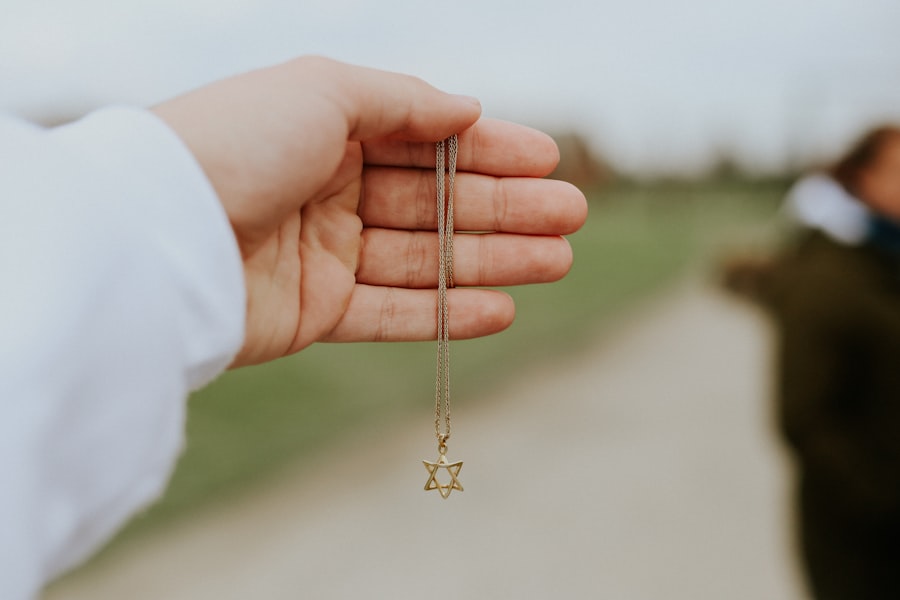Fashion trends have a profound impact on consumer behavior, particularly in the realm of accessories such as gold jewelry. As designers unveil their collections each season, the styles and aesthetics they promote can significantly influence what consumers desire. For instance, during the 1980s, bold and chunky gold pieces became a staple, reflecting the era’s penchant for excess and opulence.
This trend was not merely a reflection of personal taste but also a response to the cultural zeitgeist, where individuals sought to express their wealth and status through conspicuous consumption. As fashion houses like Versace and Chanel showcased oversized gold chains and statement earrings, the demand for similar pieces surged, leading to a boom in gold jewelry sales. In recent years, the resurgence of minimalist fashion has shifted the focus toward delicate and understated gold jewelry.
Brands such as Mejuri and Missoma have capitalized on this trend by offering fine gold pieces that cater to a more subtle aesthetic. The demand for dainty necklaces, stackable rings, and simple hoop earrings has increased as consumers gravitate towards jewelry that complements their everyday attire rather than overpowering it. This shift illustrates how fashion trends can dictate not only the style of jewelry but also its perceived value and desirability in the marketplace.
Key Takeaways
- Fashion trends have a significant influence on the demand for gold jewelry, with consumers seeking to align their accessories with current styles.
- Celebrity endorsements play a crucial role in shaping gold jewelry trends, as fans often emulate the styles of their favorite stars.
- Social media has a profound impact on gold jewelry trends, with influencers and online platforms driving consumer preferences and purchasing decisions.
- Fashion weeks serve as a catalyst for increased gold jewelry sales, as designers and fashion houses showcase their latest collections, often featuring gold accessories.
- Cultural and regional trends heavily influence gold jewelry demand, with different cultures and geographic locations favoring specific styles and designs.
- Sustainable and ethical practices in gold jewelry production are increasingly important to consumers, who seek transparency and responsible sourcing in their purchases.
- The future of gold jewelry trends in the fashion industry is likely to be shaped by a combination of sustainability, technology, and evolving consumer preferences.
- When investing in gold jewelry based on fashion trends, it’s important to consider the longevity of the trend, the quality of the piece, and its potential resale value.
The Role of Celebrity Endorsements in Shaping Gold Jewelry Trends
Celebrity endorsements play a pivotal role in shaping consumer perceptions and driving trends within the gold jewelry market. When high-profile figures don specific pieces, they often set off a chain reaction that influences public interest and purchasing behavior. For example, when Beyoncé was spotted wearing a stunning gold necklace at a major awards show, it sparked a surge in demand for similar designs.
Her influence extends beyond mere visibility; it encapsulates a lifestyle that many aspire to emulate. This phenomenon is not limited to music icons; actors, athletes, and influencers also wield significant power in dictating what is fashionable. Moreover, collaborations between celebrities and jewelry brands have become increasingly common, further blurring the lines between fashion and marketing.
Rihanna’s partnership with Chopard introduced a line of luxurious gold jewelry that combined her unique style with the brand’s heritage. Such collaborations not only elevate the brand’s profile but also create a sense of exclusivity that appeals to consumers. The allure of owning a piece associated with a beloved celebrity can drive sales and foster brand loyalty, demonstrating the profound impact that celebrity culture has on gold jewelry trends.
The Impact of Social Media on Gold Jewelry Trends

Social media platforms have revolutionized the way consumers discover and engage with fashion trends, including gold jewelry. Instagram, Pinterest, and TikTok serve as visual showcases where users can explore an endless array of styles and inspirations. Influencers and content creators often curate their feeds to highlight specific pieces of jewelry, leading to viral trends that can propel certain designs into the spotlight overnight.
For instance, the rise of “ear stacking,” where multiple earrings are worn in one ear, gained momentum through social media influencers showcasing their unique combinations of gold hoops and studs. Additionally, social media allows for real-time feedback and interaction between brands and consumers. Jewelry brands can gauge interest in specific styles through likes, shares, and comments, enabling them to adapt their offerings accordingly.
This dynamic relationship fosters a sense of community among consumers who share similar tastes and preferences, further driving demand for trending gold jewelry pieces. The immediacy of social media also means that trends can shift rapidly; what is popular today may be forgotten tomorrow, compelling brands to stay agile and responsive to consumer desires.
The Connection Between Fashion Weeks and Gold Jewelry Sales
| Year | Fashion Weeks | Gold Jewelry Sales |
|---|---|---|
| 2018 | 4 | 1.2 billion |
| 2019 | 5 | 1.5 billion |
| 2020 | 3 | 1.1 billion |
| 2021 | 4 | 1.3 billion |
Fashion weeks around the world serve as critical platforms for designers to showcase their latest collections, including gold jewelry. These events not only set the tone for upcoming seasons but also create significant buzz that translates into consumer interest and sales. For instance, during New York Fashion Week, designers often incorporate bold gold statement pieces into their runway shows, capturing the attention of fashion editors, buyers, and influencers alike.
The visibility gained from these events can lead to increased demand for similar styles in retail markets. Moreover, the timing of fashion weeks aligns with consumer purchasing cycles, creating a direct correlation between runway trends and sales figures. As consumers eagerly anticipate new collections, they often seek to replicate the looks they admire on the runway.
This phenomenon was evident during the Spring/Summer 2022 shows when several designers featured intricate gold jewelry designs that resonated with audiences. Retailers quickly adapted by stocking similar items, resulting in a spike in sales as consumers rushed to embrace the latest trends showcased on the catwalk.
How Cultural and Regional Trends Affect Gold Jewelry Demand
Cultural influences play a significant role in shaping gold jewelry demand across different regions. In many cultures, gold is not merely an accessory but a symbol of wealth, status, and tradition. For example, in South Asian countries like India and Pakistan, gold jewelry is integral to weddings and festivals, often passed down through generations as heirlooms.
The demand for intricate gold designs adorned with gemstones reflects cultural values surrounding family heritage and celebration. This cultural significance drives consistent demand for gold jewelry in these regions, regardless of global fashion trends. Conversely, Western markets may prioritize contemporary designs that align with modern aesthetics while still valuing gold’s intrinsic qualities.
In places like Europe and North America, there is a growing appreciation for artisanal craftsmanship and unique designs that tell a story or reflect personal identity. This shift has led to an increase in demand for bespoke gold jewelry pieces that cater to individual tastes rather than mass-produced items. As consumers become more conscious of their purchasing decisions, they seek out pieces that resonate with their cultural backgrounds or personal narratives.
The Importance of Sustainable and Ethical Practices in Gold Jewelry Production

The Growing Demand for Sustainable Gold Jewelry
As consumers become more aware of environmental issues, they are increasingly prioritizing sustainability and ethical practices in their purchasing decisions, including gold jewelry. The mining of gold has historically been associated with significant environmental degradation and human rights abuses. In response to these concerns, many brands are adopting sustainable sourcing practices that ensure their materials are ethically obtained.
Adopting Sustainable Sourcing Practices
Companies like Brilliant Earth focus on sourcing recycled gold or gold mined under strict environmental standards, appealing to eco-conscious consumers who want to make responsible choices. Moreover, transparency in the supply chain has become a critical factor for consumers when selecting jewelry brands. Many are now seeking out certifications or assurances that their purchases support fair labor practices and environmentally friendly methods.
The Shift Towards Sustainable Practices in the Jewelry Industry
This shift has prompted traditional jewelers to reevaluate their sourcing strategies and adopt more sustainable practices to remain competitive in an evolving market. As consumers become more informed about the implications of their purchases, brands that prioritize ethical practices are likely to see increased loyalty and demand.
A New Era of Responsible Jewelry Consumption
The growing demand for sustainable gold jewelry is driving a new era of responsible consumption in the industry. As consumers continue to prioritize sustainability and ethics, brands that adapt to these changing values are likely to thrive in the market.
The Future of Gold Jewelry Trends in the Fashion Industry
Looking ahead, the future of gold jewelry trends within the fashion industry appears poised for continued evolution driven by various factors including technology, consumer preferences, and cultural shifts. One notable trend is the increasing integration of technology into jewelry design and marketing. Augmented reality (AR) applications allow consumers to virtually try on pieces before making a purchase decision, enhancing the shopping experience while reducing returns.
This technological advancement could reshape how consumers interact with gold jewelry brands and influence their buying habits. Additionally, as younger generations become more influential in the market, their preferences will likely dictate future trends. Millennials and Gen Z consumers tend to favor authenticity and individuality over traditional luxury markers.
This shift may lead to an increased demand for unique designs that reflect personal style rather than conventional notions of opulence associated with gold jewelry. Brands that can adapt to these changing preferences while maintaining quality craftsmanship will be well-positioned to thrive in this dynamic landscape.
Tips for Investing in Gold Jewelry Based on Fashion Trends
Investing in gold jewelry requires careful consideration of current fashion trends as well as timeless design elements that ensure longevity in both style and value. One key tip is to focus on classic pieces that transcend seasonal trends; items such as simple gold hoops or elegant pendants can remain fashionable over time while retaining their intrinsic value. Additionally, investing in designer collaborations or limited-edition collections can offer potential appreciation due to their exclusivity.
Another important aspect is to pay attention to quality over quantity; investing in fewer high-quality pieces crafted from solid gold rather than costume jewelry can yield better long-term returns. Understanding market trends through research—such as following fashion weeks or monitoring social media influencers—can provide insights into which styles are gaining traction. By aligning investment choices with emerging trends while prioritizing quality craftsmanship, investors can navigate the evolving landscape of gold jewelry effectively.
If you’re interested in understanding how broader market trends, including those in fashion, can influence specific industries, you might find the article “The Impact of AI on Future Businesses” insightful. It explores how technological advancements are reshaping various sectors, much like how fashion trends can drive demand in the jewelry market. To delve deeper into this topic, you can read the article here.
